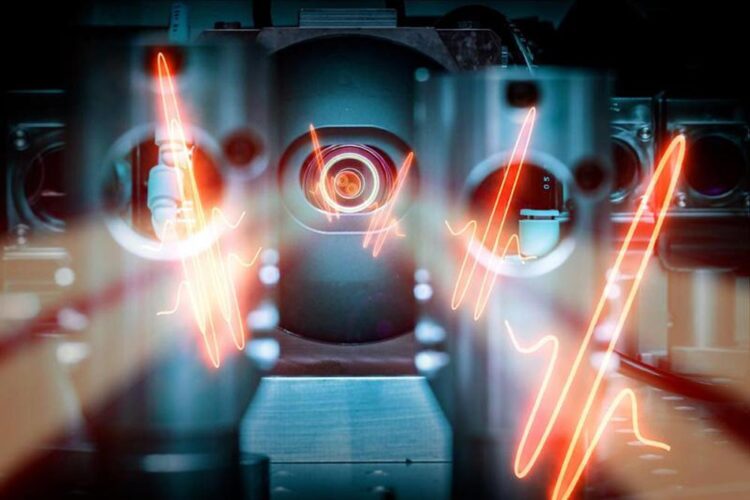Most powerful dual-comb spectrometer developed

Two trains of laser pulses with slightly different spacing originate from a thin-disk laser gain medium in the center of the picture. The work was recently published in Nature Communications.
HSU/Eric Schambroom
Scientists from Hamburg and Munich developed the world’s most powerful dual-comb spectrometer that paves the way for many applications in atmospheric science and biomedical diagnostics, such as early cancer detection. The work has recently been published in Nature Communications.
The core part of the system is a special type of laser-gain medium, a thin-disk, and a unique configuration of the mirrors surrounding this medium, a laser resonator (shown in the illustration). “The key of our dual comb laser source lies in its simplicity”, team leader Oleg Pronin explains. “Instead of using two separate lasers, actively stabilizing and locking them to each other, our two laser outputs originate from the same laser resonator, leading to an excellent intrinsic mutual stability.” The dual-output laser yields one order of magnitude higher power than ever before. This paves the way for many applications in atmospheric science and biomedical diagnostics, such as early cancer detection. Fundamental research applications such as precise measurements of the atomic lines in uncovered spectral ranges and nuclear clocks, the most precise clocks in our universe, come into reach thanks to this novel spectrometer.
The dual-comb spectrometer converts extremely fast electric field oscillations (10¹⁵ oscillations per second) of light into radiofrequency range (10⁶ oscillations per second), where the signal can be detected in real-time with modern electronics. The process is realized with two trains of laser pulses with slightly different spacing. It offers high sensitivity and resolution with fast acquisition times in the millisecond time scale. Megawatt level peak powers pave the way toward high-resolution spectroscopy in the deep ultraviolet frequency range via frequency conversion – a spectral domain yet poorly covered in today’s spectrometers. Compared to complex, actively stabilized laser systems, the compact size facilitates real-world applications, such as atmospheric sensing and high-precision distance measurements.
Wissenschaftliche Ansprechpartner:
Prof. Dr. Oleg Pronin, Laser Technology & Spectroscopy, e-mail oleg.pronin@hsu-hh.de
Originalpublikation:
Fritsch, K., Hofer, T., Brons, J. et al. Dual-comb thin-disk oscillator. Nat Commun 13, 2584 (2022).
DOI: https://doi.org/10.1038/s41467-022-30078-0
Media Contact
All latest news from the category: Process Engineering
This special field revolves around processes for modifying material properties (milling, cooling), composition (filtration, distillation) and type (oxidation, hydration).
Valuable information is available on a broad range of technologies including material separation, laser processes, measuring techniques and robot engineering in addition to testing methods and coating and materials analysis processes.
Newest articles

Superradiant atoms could push the boundaries of how precisely time can be measured
Superradiant atoms can help us measure time more precisely than ever. In a new study, researchers from the University of Copenhagen present a new method for measuring the time interval,…

Ion thermoelectric conversion devices for near room temperature
The electrode sheet of the thermoelectric device consists of ionic hydrogel, which is sandwiched between the electrodes to form, and the Prussian blue on the electrode undergoes a redox reaction…

Zap Energy achieves 37-million-degree temperatures in a compact device
New publication reports record electron temperatures for a small-scale, sheared-flow-stabilized Z-pinch fusion device. In the nine decades since humans first produced fusion reactions, only a few fusion technologies have demonstrated…





















